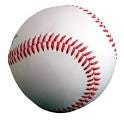Fat Pat at Bat
In honor of J.D. Martinez’s four-homer game on Monday, I’ll post a couple of relates pieces … starting with this one on one of the most unlikely men to have had hit four home runs in a game.
On July 19, 1948, first game of a doubleheader, the craziest thing happened: A guy named Pat Seerey hit four home runs in a game. Well, no one really called him Pat Seerey. They called him “Fat Pat.” They called him “Mr. Five-by-Five.” They called him “The People’s Choice.” The papers called him “rotund outfielder” and “the flabby Oklahoman” — the second of those unquestionably the worst name ever for a Western movie.
Seerey is listed for posterity at 5-foot-10 and 200 pounds which ain’t bad, but in his day they had Seerey an inch or two shorter than that and 25 to 30 pounds heavier. Height and weight aside, Pat Seerey was what passed for a strikeout machine in the 1940s. He never got 500 plate appearances in a season and yet he led the league in strikeouts four times. In 1944, he struck out 99 times in 342 at-bats.
This isn’t to say that Pat Seerey lacked talent: He had prodigious power. That’s why Cleveland manager Lou Boudreau kept sending Seerey to the plate in spite of all those whiffs. When Seerey got hold of one, the ball went a long way. One July day in 1945, at Yankee Stadium, he hit three home runs and a triple. It seems that Boudreau did not particularly like Seerey, but he still brought in three all-time greats — Hank Greenberg, Tris Speaker AND Rogers Hornsby — to serve as personal batting instructors. It didn’t take.
“I’m sort of a rockhead,” Seerey said.
Cleveland finally gave up on him in 1948, ironic because that was year Seerey lost a bunch of weight in the offseason (earning him the nickname “Flat Pat.”). They traded him to Chicago for Bob Kennedy. It was a good trade for Cleveland; Kennedy proved to be a useful enough player for five seasons while Seerey would be out of the Major Leagues within a year. But Seerey still had that historic day, July 19, 1948, at Shibe Park in Philadelphia.
First time up, against Carl Scheib, he struck out. But in the fourth inning, first pitch, he hit the ball over the left-field roof. That’s one. Next inning, he hit Scheib’s first pitch off of the roof. That’s two. One inning later, he hit another ball off the roof. That’s three.
The next inning, though, he popped out to the catcher and in the ninth inning he walked and that probably should have ended things. But his A’s had somehow come back from an 11–7 deficit (Eddie Joost’s three-run homer wa the big blow) and so the game went into extra innings.
And in the 11th, Seerey hit one deep into the left-field stands off of war-hero Lou Brissie — an amazing story for another time — to become the fifth player in Major League history to hit four homers in a game, and only the second American Leaguer after Lou Gehrig.
There are several fun details from that game. One is that George Earnshaw — who gave up three of Gehrig’s home runs — was in the press box watching. He was working for the American League at the time. Earnshaw told a great story about how, after he gave up that third home run to Gehrig (he actually gave up back-to-back homers to Ruth and Gehrig that inning), he was pulled from the game. But his manager Connie Mack would not let him go to the clubhouse. Mack insisted that Earnshaw watch closely as Roy Mahaffey faced Gehrig in the top of the seventh.
“Watch, maybe you’ll learn something,” Mack said, or something to the effect.
Gehrig promptly hit his fourth home run of the game.
“Is that what you mean, Mr. Mack?” Earnshaw said, and he headed for the showers.
One more little story: Weather King batteries had an ad in the Philadelphia program offering $300 to any ballplayer — home or visitor — who hit three home runs in a game.
Apparently the ad USED to promise $300 for three home runs … and $500 for four home runs. But the idea of anyone hitting four homers in a game was so unlikely, that they simply took that option off the ad.
After Seerey hit his third home run, clarification was needed. Did the $500 offer still stand? This wasn’t a trivial matter; Seerey never made more than $12,000 in a season, this was real money. Apparently calls were made, Weather King representative Charlie Ziehler confirmed during the game that the $500 prize was still in place. Seerey knew what was at stake in his last at-bat. Ziehler gave Seerey the check the next day.
And a final addendum: In 1894, Boston’s Robert Lowe — sometimes called Bobby or Linc or Link — became the first player in the so-called Majors to hit four homers in a game. As one paper wrote: “Linc Lowe made a record for himself in Wednesday’s game at Boston against Cincinnati that any ball player might be proud of. In the afternoon game Linc had 4 home runs, 2 putouts and 2 assists.” It is those two assists that he undoubtedly would never forget.
In any case, Lowe was 80 when he heard that Seerey got 500 bucks for his four-homer game. He could not help but laugh. “What did I get?” he told reporters. “Why I got a nice big headline. There was some talk at the time of raising a $1,000 purse, but I never got a dime.”
Originally published at joeposnanski.com on September 5, 2017.
